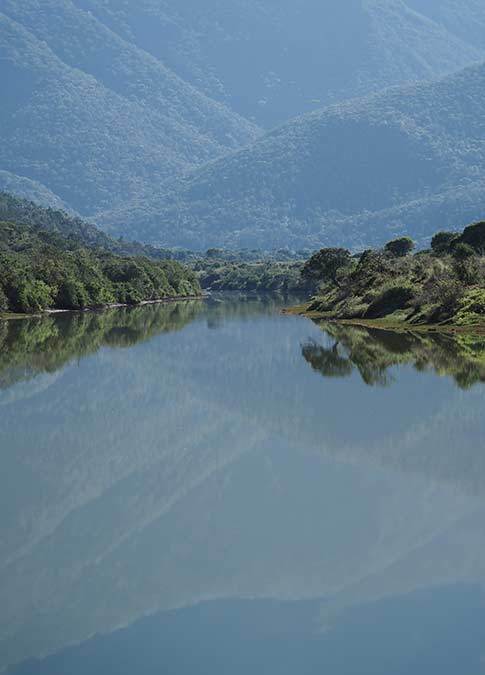Thicket Mosaic
The restaurant at the Main Lodge is surrounded on three sides by the twisted branches of trees punctuated by the great green candelabras of the tall euphorbias and in winter by the scarlet-flowered aloes. These thickets are the remnants of a forest that once spread along the east and south coasts of Africa from the equator to the southern Cape. During the course of thousands of years the climate became drier and the forest shrank in both extent and in the size of the trees. Its remnants are now to be found only in the river valleys, on the coastal dunes, and here on the escarpment and adjacent slopes overlooking the ocean. To the south the coastal thicket is low and all but impenetrable, likewise in the drier areas to the north, but here at Kariega with an annual rainfall of 500 mm or more, the trees are taller and it is often possible to find a way beneath the canopy. Vines twist through the undergrowth, reaching for the light, and beneath the branches and at the thicket edge there are numerous herbs and bulbs. In places there are natural clearings covered with grass, forming together with the thicket a mosaic of plant communities. Here before the advent of the hunters was to be found one of the densest concentrations in Africa of herbivores, both browsers and grazers. There were antelopes both great and small, bush-pigs and porcupines, but the greatest mass of these plant-eating animals consisted of elephants, rhinos, hippos and buffaloes, and it was they that forced their way through the thicket creating paths that exist to this day.
The Xhosa with their assegais first entered the area at the start of the 18th century, but their hunting made a relatively small impact on the herds. In 1797, almost a century after the first Xhosa huntsmen entered the land between the Bushman and Kariega rivers, and some 25 years after the first Dutch hunters, John Barrow recorded meeting a “Mr Rensburg” who told him that he had come across a herd of between 400 and 500 elephants between the Bushmans and Kariega Rivers.* Even allowing for some exaggeration, it is obvious that in 1820 when British settlers were first granted farms, game was still plentiful. It then took only 20 years for most of the large animals to be exterminated, the buffalo hanging on for the longest: the last recorded buffalo in the Bathurst district being shot, it was thought by poachers, on the farm Elephant Park “in about 1918”.*
The thicket provided a sanctuary for some of the smaller animals. My father who was born in 1888 on the farm Barville Park, east of the Kariega and who spent a part of his youth on the farm Layton, to the north near the river’s source, remembered the stories his grandparents told of encounters with elephants and buffaloes, but by the time he was old enough to go on hunting trips with his older brothers there were only bushbuck and occasionally bush-pig or mountain reedbuck. On one memorable occasion on Barville Park they shot a springbuck. So unusual was this that they feared that they might have killed a farmer’s pet and expected at any moment to be faced by a furious neighbour. Fortunately there was no irate banging on the farm front door either that day or subsequently.
On a recent visit to Kariega we were unable to take one of our normal walks because a hippo had been spotted near the chalets. Although we were disappointed not to be able to walk, we were delighted to be reminded that hippos are once again to be found not only in, but occasionally between the rivers, as are of course elephants, rhinos and buffaloes. So often today one hears only tales of gloom and doom, of global warming, species extinction and loss of habitat, but at Kariega Park at least there is some hope for the future.
That night in front of the fire I thought of how surprised and delighted my father would have been to know that the creatures that his forefathers encountered – and did their bit in exterminating - once again roam the thicket mosaic between the Bushmans and Kariega Rivers.
* Barrow, J. 1801. An account of travels into the interior of Southern Africa… Vol 1. London. Pages 177-8.
* Jones, EM. 1969. Role of the British Settlers in South Africa, Part 1 up to 1826. Cape Town. Page 188.









